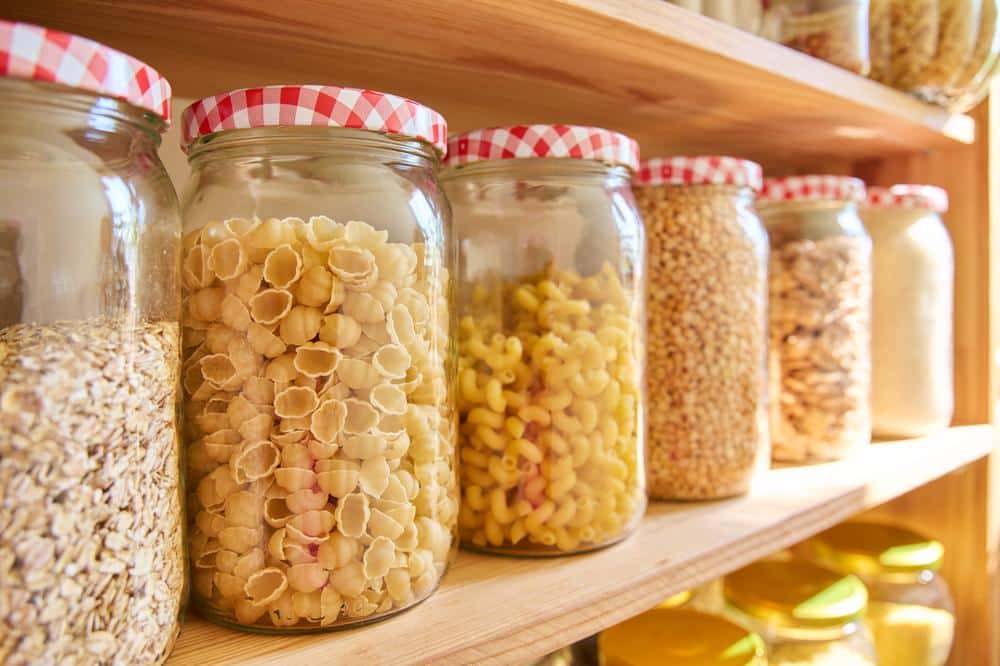If you’ve noticed small moths fluttering around your pantry, you’re likely dealing with pantry moths. These unwelcome invaders can wreak havoc in your kitchen, so it’s important to get rid of them as quickly as possible.
A small gray or brownish moth in your kitchen pantry or cabinet may appear harmless, but it is not to be taken lightly. This tiny moth is most likely the adult stage of the Plodia interpunctella insect species, and where adult moths are present, eggs, pupae (caterpillars), and pupal shells are most likely present as well. With a single female moth capable of laying up to 400 eggs, each of which can complete the lifecycle in about 50 days, you may already be dealing with a major infestation.


Biology of the Pantry Moth
Table of Contents
- Biology of the Pantry Moth
- Where Do Pantry Moths Come From?
- Many Ways to Get Rid of Pantry Moths
- Clean out your Pantry / Kitchen Cupboards
- Change Storage Methods in The Pantry
- What Causes Pantry Moths?
- How to Prevent Pantry Moths
- Pantry Moths vs. Clothes Moths
- What are pantry moths most attracted to?
- How do I find a pantry moth nest?
- How long does it take to get rid of pantry moths?
- What can I use for pantry moths?
- How do I know if I have pantry or moths?
- What is the fastest way to get rid of pantry moths?
- How do pantry moths start?
- Do pantry moths lay eggs in clothes?
- Do pantry moths fly around the house?
- Do pantry moths eat wool clothing?
- What smells do pantry moths hate?
- What kills pantry moth eggs?
- Can pantry moths survive in the fridge?
- How do you stop pantry moths?
- Can pantry moths get into Ziploc bags?
- How do I keep my pantry moths from coming back?
- Where do pantry moths lay their eggs?
- Can pantry moths get into glass jars?
- Why do I suddenly have moths in my house?
- How long do pantry moths live?
- Are pantry moths seasonal?
- How do you get rid of pantry moths?
- Why do I have pantry moths?
- What do pantry moths hate?
- How do you get rid of a moth infestation?
- What is the fastest way to get rid of moths?
- What is the best pantry moth repellent?
- Do pantry moths hate vinegar?
- Can you starve pantry moths?
- What is the lifespan of a pantry moth?
- Can pantry moths lay eggs on clothes?
- What do moth eggs look like?
- Do pantry moths eat pasta?
- Do pantry moths eat coffee?
- Does vinegar attract pantry moths?
- What actually kills moths?
- What smell kills moths?
- How do you find a moth nest?
- What is a natural killer for moths?
P. interpunctella is one of several insects that have been observed feeding on stored grains and other dry foods. It is also known as the pantry moth, Indianmeal moth, flour moth, grain moth, and weevil moth. The adult moth is quite small, measuring 1/4 to 3/8 inch in length with a wingspan of 1/2 to 3/4 inch, making it easy to overlook until the insects overrun your kitchen storage space.
The insect can be found almost anywhere in the United States. These pests will eat almost any dry food, particularly raw and processed grains, cereals, pastas, and dog and cat food. In most cases, the initial infestation occurs at a commercial food processing or packaging facility and enters your home through packaged foods, so an infestation is not a result of your own poor housekeeping.
Hundreds of tiny white eggs laid by adult female moths hatch in a few days into small white caterpillar larvae less than 1/2 inch long, which spend the next few weeks spinning webs and eating your stored foods before forming pupae that will hatch into more moths. The entire process can take anywhere from one to ten months, so by the time you notice visible moths, there is a good chance you have a serious infestation in any dry food containers that are not airtightly sealed.
The webbing in the corners of pantries and cupboards is often the first sign of pantry moths—but it’s better than pouring a cup of flour full of squirming white worms.

Where Do Pantry Moths Come From?
The meal pantry moths are the fiercest of all caterpillar pests. These insects can cause retail food chains to shut down, as their chow knows no bounds! The female deposits up to 400 eggs at once—and you’ve got about 30 days until they hatch into larvae that will eat anything from grains and cereal products (including Cap’n Crunch) right through meats like chicken or beef jerky before spinning cocoons in which to emerge transformers into moths ready for another round…
Mealists aren’t just found near human settlement but rather occur throughout nature–sometimes even appearing fortress-like constructions such as the one seen here diagrammed below

Many Ways to Get Rid of Pantry Moths
It is not difficult to get rid of a pantry moth infestation, but it does require some effort. Mostly, it’s a matter of carefully inspecting each dry food item in your storage area, discarding affected items, and thoroughly cleaning the area before restocking. Pesticides are not an option for getting rid of pantry moths because they live in food storage areas.

Control, Remove, and Discard Pantry Moths
Examine all of the food in your pantry for signs of infestation. Larvae can be found in and on food packaging. Look for webs as well, as these may belong to moths rather than spiders.
Moths prefer grain-based products such as flour, cereal, pasta, and baking mixes, as well as nuts and sweets. However, do not limit your search to these items. Larvae can be found tucked into can edges, on spice jars, and even in unopened packages and sealed canisters. Check their food as well if you have pets. To kill the larvae, discard any infested foods and wipe down any affected cans with undiluted vinegar. Infested items should be disposed of in your outdoor trash can. Placing them in your kitchen trash will only exacerbate the situation.
If you plan to keep grain and nut products, place them in the freezer for a reasonable amount of time if you have the space. Before putting them back in the cupboard or pantry, make sure you’re certain you’ve solved the problem.

Regularly check your Pantry
The chances are that if you’re reading this, it’s because your pantry has been infested with moths, and the question on everyone’s mind is, “why does my food cabinet have these bugs? Where do they come from?” We can easily leave old, outdated grocery items stored in our cabinets without being mindful of where we put them. The result: A pile of uneaten dishes collecting dust at the back while encouraged by an environment perfect for pests like cupboard moths who thrive off human neglect! Checking what we’ve got before moving anything around will ensure nothing goes wasted – not even those pesky little buggers known as “pantry.

Check all food stored in your Pantry for Moths
Do you have a feeling that something is off with your pantry? Is it possible there are moths living in the cracks and crevices of each item, hidden from sight until they hunger strike at nightfall to consume their prey – us? Pantry moth infestation symptoms can vary depending on what food products or ingredients we’re talking about. If dry foods for pets fall into this category then be particularly concerned because these bags often don’t go through rigorous sealing procedures before being placed onto shelves which leaves them vulnerable once again as eggs/larvae wait patiently just out viewing.

Dispose of all Pantry Moth-infested Foods
Moth-covered food is never a good sign! If you find any items in your pantry that are out of date or infested with moths, don’t hesitate to throw them away. However, if it’s possible for the container holding these unwanted goods to remain usable despite being covered by bugs—then be sure take note because there may still another source where meal moth eggs could potentially end up getting laid down when no one paid attention before Bite Night
Clean Your Containers
Pantry moths can be a pesky pest in your home, but don’t worry! The good news is that with some careful cleanings and inspections of reusable food storage containers you’ll have them under control. First things first: ensure all dirty dishes are removed from the dishwasher or hot soapy water will do wonders for getting rid any eggs left behind by these pests (not to mention how great it feels after washing hundreds upon thousands off). After rinsing thoroughly place items back into their appropriate places; make sure no new tenants have taken up residency inside other cabinets.

Clean out your Pantry / Kitchen Cupboards
Vacuum all surfaces and pay attention to cupboard corners, cracks & crevices for moths. It’s easy to spot adult flying pantry moths, but less so their eggs which might be hidden amongst dust or in Webbing left behind when they shed their skins (or “cast off,” as it says here). Vacuum outside the home then seal up tight; make sure you tie lot of knots – remember there could even still exist tiny Pantry Moth Cocoons waiting beneath those layers!

Clean Everything in the Pantry
Clean out your pantry or cupboard thoroughly. Remove your shelf liners and either wash or replace them. Vacuum the shelves thoroughly, focusing on the corners, undersides, shelf brackets, and mounting hardware. Walls, baseboards, trim, floor, ceiling, and door should all be vacuumed (including the inside edge, hinges, and knob). Then, mop the floor and wipe down your pantry shelves with hot, soapy water or vinegar. When you’re finished cleaning, remove the vacuum bag and place it in your outside trash can (wash out the dust compartment if you used a bagless vacuum). You don’t want moth larvae to breed in your vacuum.
Vacuum the area, then clean with a vinegar-and-water solution.
Once you’ve finished vacuuming, empty the bag and tie it off in a garbage can outside. Next, take care of that pesky pantry moth problem by washing all affected areas with a 50% solution mixture made up mostly of vinegar and some warm water so as not to scorch your floor’s finish! If possible, try adding peppermint oil to this last part because who knows what these critters are eating? Finally, give everything one last wipe down before mop-ping away – make sure include a bleach head if yours has been used on
Change Storage Methods in The Pantry
If you have the space, keep many grain or nut products in the freezer or refrigerator instead of the pantry or cupboards. Consider storing new groceries in a different location (i.e., a good distance from the pantry). This can be a long-term strategy, or you may want to do it until you’ve had a chance to thoroughly inspect the affected pantry and ensure the problem has been resolved.
Additionally, consider storing grains and other dry foods in mason jars, tins, or other airtight containers. This way, if you bring food home from the grocery store that contains eggs, the moths won’t be able to get out of the jar when they hatch, leaving you with only that one jar of food to throw away.

What Causes Pantry Moths?
Pantry moths almost always enter your home via purchased dry food items that have been contaminated at the food processing or packaging plant. They can spread once inside your home if the products are stored in a cardboard or thin plastic containers that allow the larvae to eat through and spread to other containers.
This insect only feeds on dry food materials, particularly grains, and it needs warm temperatures to breed and thrive. Even temporary storage in the freezer will kill any insects that are present. This cold storage is a common strategy in areas where pantry moths are prevalent.
How to Prevent Pantry Moths
To avoid future infestations, keep flour, baking mixes, oatmeal, and nuts in the freezer, or freeze them for a week before storing them in the pantry. It will kill any larvae that may be present in the foods you bring home from the store, preventing them from entering your pantry.
Moths are known to be repelled by bay leaves, lavender, cedar, and mint. Fill sachets with one of these and tuck them inside your pantry to serve as a deterrent. Replace them on a regular basis to ensure their effectiveness.
Clean up any food spills in your pantry as soon as they occur, and give your pantry a thorough cleaning at least once a year. It will assist you in avoiding infestations and will alert you to any potential problems before they become a problem.
If you keep a grocery stockpile, make sure to inspect it for moth activity on a regular basis and follow the same food storage practices that you do in your kitchen. Because you probably don’t visit your stockpile as frequently as you do your pantry, a problem could easily go unnoticed.

Pantry Moths vs. Clothes Moths
Pantry moths are distinct from the common moths that damage fabrics in closets and dressers. Tinea pellionella and Tineola bisselliella are the two most common fabric-eating moths. They have the same shape and size as pantry moths, but these insects are not known to infest food-storage areas. Pantry moths have more distinct reddish-brown hues on the outside of their wings, whereas clothes moths are more uniformly gray.
However, insects occasionally lay eggs on nearby fabrics in a home with a severe pantry moth infestation. Pantry moth webbing and even tiny caterpillar larvae may be found in clothing storage areas near pantries and other food storage areas. Pantry moths, on the other hand, do not consume textile fabrics. If you notice holes in your clothing, the infestation is most likely caused by clothes moths rather than pantry moths.
What are pantry moths most attracted to?
There are many pantry moth attractions, but one that stands out is the presence of flour. They’re attracted not only by your cereal and bread products- if it has been stored in an open bag or container without protection from insects, this can also cause problems with moths entering into homes through these items during shipment processes where they might have become infested while being transported between facilities contaminated near areas known for high populations rates
How do I find a pantry moth nest?
In the pantry, you may find larvae and pupae tucked away in door hinges or the back of cupboard shelves. They can also be found underneath jar lids; cans that are not food items but still have an effect on your home’s cleanliness when they’re stored there without being consumed by insects first!
How long does it take to get rid of pantry moths?
In order to get rid of the moths and hatching larvae that have infested your house may take up to six months. Hold off on restocking pantry items (beyond what you need short-term) until they are gone for good!
What can I use for pantry moths?
Moths and other insects that feed on food often create messes in your pantry. To keep them at bay, sprinkle diatomaceous earth around the edges of shelves where they’re likely to hang out and inside corners near doorways or windows, so you can get rid of this problem once and for all!
How do I know if I have pantry or moths?
The pantry moth may look like an ordinary fly, but it’s not as mobile and will only travel a short distance from its food source. On the other hand, adult clothing moths tend to stay close by to locate new victims for their larvae eating!
Beware: They both have big eyes that give them away when you see one because these insects can’t hide what they’re doing like some people think we do— flies don’t fluster or worry about covering up any tracks left behind either way.
What is the fastest way to get rid of pantry moths?
Start by inspecting your pantry for any unwanted items that may have been left behind. Make sure to take note of anything you see and dispose of or donate these materials so they don’t go bad before being used again! Next, vacuum up all dust from around the room using a powerful machine with wide blades as this will get rid of most dirt particles easily without incorporating more back into its system while also removing couplings friends who own pets might bring along on walks at times too.
How do pantry moths start?
The pantry moth is a hungry invader that can enter your home in many ways. They love to prey on our beloved dried foods and, if left unchecked, will soon fill up with tasty snacks like cereal or nuts! To prevent an infestation, you need to keep tight control of food sources by storing sealed containers away from these pests at all times when not being used as well as washing out any spills immediately so they don’t inspire more than just curiosity from this ever-so elusive creature.
Do pantry moths lay eggs in clothes?
Pantry moths love to chow down on our food! They can be found wherever there is plenty of fabric- such as closets, shelves, and even clothes storage areas near pantries. You may find signs that they’ve been webbing your suit wear or curtains with their drool-covered needles, which will turn brown when touched by an insect carrying the fungus.
Do pantry moths fly around the house?
These little brown moths are often found around the house, especially in dusty places like behind light switches or electric panels. They might even find their way into your cupboards! But don’t worry- they’re not supposed to be there anyway; sometimes they happen upon an overlooked trap door while looking for food (don’t worry…it won’t hurt you).
Do pantry moths eat wool clothing?
Moths and pantry months are a perfect match. These insects can lay eggs where they’re most likely to find food, such as in grains or flour; while moths feed on natural fabrics like leather wool silk that we store away for future use during their vulnerable stages when unfed (panting).
What smells do pantry moths hate?
Wipe down the shelves with white vinegar to keep your home free of pesky pantry insects. If you want to give it an extra seal of protection for even more peace-of-mind while storing food items in tight spaces like cabinets or drawers, add some essential oils! These natural disinfectants will do wonders at repelling these unwanted guests, so they don’t come back again anytime soon.
What kills pantry moth eggs?
First, wash the inside with soap and water to keep your pantry or cabinet clean. Next, mix a weak bleach solution to kill any eggs hiding somewhere on these surfaces! Afterward, rinse off all of those pesky flies who love living there too much by using our favorite weapon: vinegar mixed with peppermint oil – it works like magic to repel them away from what’s important, yours (and ours!).
Can pantry moths survive in the fridge?
Pantry Moths can live almost anywhere in the home, but they’ll not be happy to survive if you store your foodgrain products at freezing temperatures. That’s why it is important that we keep our groceries for about five days after purchasing them, so as long their temperature doesn’t go below freezing-40 degrees Fahrenheit (4 Celsius), these pests will have no choice other than moving onto something else!
How do you stop pantry moths?
To keep your pantry clean and pest-free, wipe down shelves with white vinegar or mix a few drops of essential oil like peppermint for disinfecting purposes. To prevent an infestation from occurring in the first place, use airtight glass jars to store foods that are not going into ovens so they don’t come into contact with other surfaces where bugs may live on them before cooking! Bay leaves also deter these pests when placed around edges near stored items.
Can pantry moths get into Ziploc bags?
The pantry moth is a gall midge that can chew through plastic and Ziploc bags to access food. These larvae have been known for their destructive chewing habits when it comes time to move around your house, so be sure not to store any items in these containers if you want them safe!
How do I keep my pantry moths from coming back?
Moth larvae and webs can be found all over your pantry. They’re especially common in corners, along shelves, or near ceilings, where they may spin their cocoons for future generations to come out as moths! To get rid of them completely, use diatomaceous earth around the edges of shelves which will cut off the food supply so these pests cannot survive – it’s environmentally friendly, too, since we rely on ocean life analogous to what our diet would consist if had never existed at some point during human history before us humans started farming practices centuries ago now isn’t that cool?
Where do pantry moths lay their eggs?
We all know that moths can be a bit scary, and they make an appearance in our kitchens from time to time. But did you also realize the Pantry moth lays eggs in flour, cereal, or pet food? That’s right! These little grayish-white creatures may look like any other pest, but their goal is quite different than most others – when it comes down to them choosing where it’s going so that these ciphers will hatch into larvae and then finally become adults again once ready for the mating season has passed (it only lasts about two weeks).
Can pantry moths get into glass jars?
It is time to clear out your kitchen pantry and other food storage areas. All items not sealed with a can, glass jar, or airtight hard container must go!
Why do I suddenly have moths in my house?
The common belief is that light attracts moths, which can sometimes be true. Moths often gather around outdoor lighting or windows at nighttime, where they may move inside through small cracks when doors are opened up wide for them to enter your house unannounced!
How long do pantry moths live?
The life cycle of the pantry moth is fascinating. The average time from when they first notice adults to when they reach maturity ranges anywhere between 4-7 weeks, with most living 1 or 2 months before turning into an egg layer and laying 650 eggs at once on any food source that will be used by their larvae–who grow up looking just like them!
Are pantry moths seasonal?
Pantry moths aren’t just seasonal visitors like cluster flies, box elder bugs, or other insect pests. They will remain in your house as long you have dry food to eat and can spread until removal efforts are made – which should always include professional assistance if possible!
How do you get rid of pantry moths?
To get rid of pantry moths, follow these steps:
- Remove infested items: Dispose of any infested food items in sealed bags and immediately take them outside to prevent reinfestation.
- Clean the pantry: Thoroughly clean pantry shelves, corners, and crevices with soap and water, followed by a vinegar-water solution to remove moth eggs and larvae.
- Store food properly: Use airtight containers or sealed plastic bags to store grains, cereals, and other dry goods.
- Use traps: Set up pheromone traps to attract and capture adult moths.
- Natural repellents: Place bay leaves, lavender, or cedar chips in your pantry as natural moth repellents.
Why do I have pantry moths?
Pantry moths are attracted to stored food products, especially grains, cereals, flour, dried fruits, nuts, and pet food. They can enter your home through open windows or doors, or be brought in with infested groceries.
What do pantry moths hate?
Pantry moths dislike strong-smelling herbs and essential oils such as bay leaves, lavender, eucalyptus, cedar, and peppermint.
How do you get rid of a moth infestation?
To eliminate a moth infestation:
- Identify the source of the infestation and remove affected items.
- Clean the infested area thoroughly with soap and water, followed by a vinegar-water solution.
- Use pheromone traps to capture adult moths.
- Launder clothing and fabrics in hot water, or freeze items that cannot be washed to kill moth eggs and larvae.
- Use natural repellents or mothballs to deter moths from returning.
What is the fastest way to get rid of moths?
The fastest way to eliminate moths is to combine thorough cleaning, proper food storage, pheromone traps, and natural repellents or mothballs.
What is the best pantry moth repellent?
The best pantry moth repellents include bay leaves, lavender, cedar chips, and essential oils like eucalyptus or peppermint.
Do pantry moths hate vinegar?
While vinegar doesn’t repel pantry moths, it is an effective cleaning agent for removing moth eggs and larvae from surfaces during the cleaning process.
Can you starve pantry moths?
Starving pantry moths can be difficult, as they can survive without food for several weeks. However, removing their food sources and maintaining proper food storage can help prevent reinfestation.
What is the lifespan of a pantry moth?
The average lifespan of a pantry moth is approximately 1-2 months, with the adult stage lasting 1-2 weeks.
Can pantry moths lay eggs on clothes?
Pantry moths typically lay eggs in stored food products, but they may occasionally infest clothing if other food sources are unavailable.
What do moth eggs look like?
Moth eggs are tiny, round, and off-white or pale gray in color. They are usually laid in clusters and can be found on food products, fabrics, or in crevices.
Do pantry moths eat pasta?
Yes, pantry moths can infest and consume pasta, along with other dry goods like grains, cereals, flour, and nuts.
Do pantry moths eat coffee?
Pantry moths are not typically attracted to coffee, but they may infest it if other food sources are unavailable.
Does vinegar attract pantry moths?
No, vinegar does not attract pantry moths. Instead, it can be used as a cleaning solution to remove moth eggs and larvae from surfaces.
What actually kills moths?
Methods for killing moths include using pheromone traps, freezing infested items, laundering fabrics in hot water, and using chemical insecticides or natural repellents.
What smell kills moths?
Moths are repelled by strong-smelling herbs and essential oils such as lavender, cedar, eucalyptus, and peppermint. While these smells don’t necessarily kill moths, they can help deter them.
How do you find a moth nest?
Moth “nests” or infestations can be found by looking for signs such as webbing, larvae, or damaged food products and fabrics. Check pantry shelves, corners, crevices, and stored items for evidence of moth activity.
What is a natural killer for moths?
Natural moth killers include freezing infested items to kill eggs and larvae, using diatomaceous earth or boric acid as insecticides, and employing natural repellents like lavender, cedar, or essential oils to deter moths.
Can You Starve Out Pantry Moths?
While removing all potential food sources can help control a pantry moth infestation, it’s not a foolproof method to completely eradicate them. Pantry moths can find hidden food sources and their larvae can survive for several weeks without food. Therefore, along with removing food sources, other measures such as thorough cleaning and the use of moth traps are generally required.
Do Pantry Moths Get into Baking Soda?
Pantry moths are generally attracted to grain-based products and other food items. While it’s not common for them to infest baking soda, they might get into it if other food sources are not available. To prevent this, it’s best to store baking soda and other pantry items in sealed containers.
Does White Vinegar Get Rid of Pantry Moths?
White vinegar can be used as a part of the cleaning process when dealing with a pantry moth infestation. It won’t kill the moths or their larvae directly, but a thorough clean with a vinegar solution can help remove moth eggs and larvae from surfaces, effectively disrupting their life cycle.
How Do You Starve Pantry Moths?
Starving pantry moths involves removing all their potential food sources. This includes cleaning out your pantry, discarding infested food items, and storing all grains, cereals, pet food, and other susceptible items in airtight containers. In addition, regular cleaning of the pantry area can help remove any hidden eggs or larvae.
How Long Do Pantry Moth Traps Last?
The lifespan of pantry moth traps can vary depending on the specific product, but on average, they tend to last around 1 to 3 months. It’s important to replace the traps regularly to ensure they remain effective. Also, keep in mind that traps are more of a monitoring tool rather than a complete solution for an infestation.
Does Apple Cider Vinegar Get Rid of Pantry Moths?
While apple cider vinegar won’t get rid of pantry moths on its own, it can be used as a homemade trap. The scent of the vinegar attracts the moths, and when combined with a few drops of dish soap in a bowl, it creates a solution that traps and kills the moths.
Is There a Difference Between Pantry Moths and Clothes Moths?
Yes, there is a significant difference between pantry moths and clothes moths. Pantry moths, also known as Indian meal moths, are typically found in the kitchen and feed on food items like grains, cereals, and dried fruits. Clothes moths, on the other hand, are often found in closets and feed on materials like wool, fur, and other natural fibers. Their life cycles, behaviors, and methods for control are also different.

Experienced Executive Assistant with a demonstrated history of working within the furniture industry. Skilled in furniture styling, visual communication, project management, and proficiency with Adobe Creative Suite. Strong arts and design professional with a (BA) Creative Direction for furniture design focused on Industrial Design from School of the Art Institute of Chicago.















